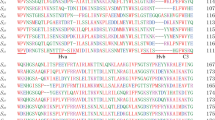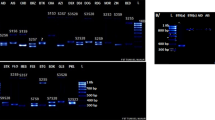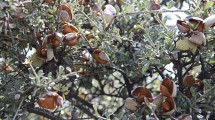Abstract
Self-incompatibility has been studied extensively at the molecular level in Solanaceae, Rosaceae, and Scrophulariaceae, all of which exhibit gametophytic self-incompatibility. In the present study, we successfully isolated nine S-RNase alleles from cultivars of Chinese cherry by PCR amplification from genomic DNA and stylar cDNA combining with cleaved amplified polymorphic sequence marker. Analysis of amino acid sequences revealed five novel S-alleles, S 2 , S 4 , S 6 , S 8 , and S 9 , with respective accession numbers in the NCBI database of EF541168, EF541173, EF541172, FJ628598, and FJ628599. Results showed that “Dongtang” and “Yinzhu” contained six S-alleles (S 1 , S 3 , S 5 , S 7 , S 8 , and S 9 ); “Taishanganying” contained four S-alleles (S 1 , S 2 , S 4 , and S 6 ); “Daiba”, “Dayingzui”, and “Xiaomizi” contained four S-alleles (S 1 , S 2 , S 5 , and S 8 ); “Laiyangduanzhi”, “Shuangquanchangba”, and “Daqingye” contained three S-alleles (S 1 , S 2 , and S 8 ). It is interesting that different cultivars collected from the same place hold the same S-genotypes. Moreover, pollination tests and pollen tube growth assays showed that nine cultivars were self-compatible. Chinese cherry presented in this article are naturally polyploidy, which is a very useful material for the study of self-compatibility, and much of this information will be valuable for further work on self-(in)compatibility of fruit tree in Rosaceae.







Similar content being viewed by others
Abbreviations
- Pps :
-
Prunus pseudocerasus
- Pa :
-
Prunus avium
- Par :
-
Prunus armeniaca
- Pd :
-
Prunus dulcis
- Pm :
-
Prunus mume
- Ps :
-
Prunus salicina
- Pspe :
-
Prunus speciosa
- Pspi :
-
Prunus spinosa
- Pb :
-
Pyrus × bretschneideri
- Pc :
-
Pyrus communis
- Ppy :
-
Pyrus pyrifolia
- Pu :
-
Pyrus ussuriensis
- Md :
-
Malus × domestica
References
Altschul SF, Gish W, Miller W, Myers EW, Lipman DJ (1990) Basic local alignment search tool. J Mol Biol 215:403–410
Altschul SF, Madden TL, Schäffer AA, Zhang J, Zhang Z, Miller W, Lipman DJ (1997) Gapped BLAST and PSI-BLAST: a new generation of protein database search programs. Nucleic Acids Res 25:3389–3402
Anderson MA, Cornish EC, Wau S-L (1986) Cloning of cDNA for a stylar glycoprotein associated with expression of self-incompatibility in Nicotiana alata. Nature 321:38–44
Beppu K, Yamane H, Yaegaki H, Yamaguchi M, Kataota I, Tao R (2002) Diversity of S-RNase genes and haplotypes in Japanese plum (Prunus salicina Lindl.). J Hortic Sci Biotechnol 77:658–664
Bŏsković RI, Wolfram B, Tobutt KR, Cerović R, Sonneveld T (2006) Inheritance and interactions of incompatibility alleles in the tetraploid sour cherry. Theor Appl Genet 112:315–326
Broothaerts W, Janssens GA, Proost P, Broekaert WF (1995) cDNA cloning and molecular analysis of two self-incompatibility alleles from apple. Plant Mol Biol 27:499–511
de Nettancourt D (1977) Incompatibility in angiosperms. Springer, Berlin
de Nettancourt D (2001) Incompatibility and incongruity in wild and cultivated plants. Springer, Berlin
Doyle JJ, Doyle JL (1987) A rapid DNA isolation procedure for small quantities of fresh leaf tissue. Phytochem Bull 19:11–15
Entani T, Iwano M, Shiba H, Che F-S, Isogai A, Takayama S (2003) Comparative analysis of the self-incompatibility (S-) locus region of a pollen-expressed F-box gene with allelic diversity. Genes Cells 8:203–213
Goldway M, Shal O, Yehuda H, Matiryahu A, Stern RA (1999) ‘Jonathan’ apple is a lower-potency pollenizer of ‘Top Red’ than ‘Golden Delicious’ due to partial S-allele incompatibility. J Hortic Sci Biotechnol 73:931–941
Halász J, Hegedűs A, Hermán R, Stefanovits-Bányai É, Pedryc A (2005) New self-incompatibility alleles in apricot (Prunus armeniaca L.) revealed by stylar ribonuclease assay and S-PCR analysis. Euphytica 145:57–66
Hauck NR, Yamane H, Tao R, Iezzoni AF (2002) Self-compatibility and incompatibility in tetraploid sour cherry (Prunus cerasus L.). Sex Plant Reprod 15:39–46
Hauck NR, Yamane H, Tao R, Iezzoni AF (2006) Accumulation of nonfunctional S-haplotypes result in the breakdown of gametophytic self-incompatibility in tetraploid prunus. Genetics 172:1191–1198
Heng W, Wu HQ, Huang SX, Zhang SJ, Wu J, Fang CQ, Zhang SL (2008a) Identification of S-genotypes and novel S-RNases in native Chinese pear. J Hortic Sci Biotechnol 83:629–634
Heng W, Wu H-Q, Chen Q-X, Wu J, Huang S-X, Zhang S-L (2008b) Identification of S-genotypes and novel S-RNase alleles in Prunus mune. J Hortic Sci Biotechnol 83:689–694
Huang S-X, Wu H-Q, Li Y-R, Wu J, Zhang S-J, Heng W, Zhang S-L (2008) Competitive interaction between two functional S-haplotypes confer self-compatibility on tetraploid Chinese cherry (Prunus pseudocerasus Lindl.CV.Nanjing Chuisi). Plant Cell Rep 27:1075–1085
Igic B, Kohn JR (2001) Evolutionary relationships among self-incompatibility RNases. Proc NatI Acad Sci USA 98:13167–13171
Ikeda K, Igic B, Ushijima K, Yamane H, Hauck NR, Nakano R, Sassa H, Iezzoni AF, Kohn JR, Tao R (2004) Primary structure futures of the S haplotype-specific F-box protein, SFB, in Prunus. Sex Plant Reprod 16:235–243
Ishimizu T, Endo T, Yamaguchi-Kabata Y, Nakamura KT, Sakiyama F, Norioka S (1998a) Identification of regions in which positive selection may perate in S-RNase of Rosaceae: implication for S-allele-specific recognition sites in S-RNase. FEBS Lett 440:337–342
Ishimizu T, Endo T, Shinkawa T, Sakiyama F, Norioka S (1998b) Primary structural features of rosaceous S-RNases associated with gametophytic self-incompatibility. Plant Mol Biol 37:931–941
Ishimizu T, Inoue K, Shinonaka M, Saito T, Terai O, Norioka S (1999) PCR-based method for identifying the S-genotypes of Japanese pear cultivars. Theor Appl Genet 98:961–967
Janssens GA, Goderis IJ, Broekaert WF, Broothaerts W (1995) A molecular method for S-allele identification in apple based on allele-specific PCR. Theor Appl Genet 91:691–698
Kao T, McCubbin AG (1996) How flowering plants discriminate between self and non-self pollen to prevent inbreeding. Proc NatI Acad Sci USA 93:12059–12065
Kimura M (1980) A simple method for estimating evolutionary rate of base substitutions through comparative studies of nucleotide sequences. J Mol Evol 16:111–120
Kumar S, Tamura K, Nei M (2004) MEGA3: integrated software for molecular evolutionary genetics analysis and sequence alignment. Brief Bioinform 5:150–163
Lane MD, Lawrence MJ (1995) The population genetics of the self-incompatibility polymorphism in Papaver rhoeas. X. An association between incompatibility genotype and seed dormancy. Heredity 75:92–97
Lawrence MD, Franklin-Tong VE (1994) The population genetics of the self-incompatibility polymorphism in Papaver rhoeas. IX. Evidence of an extra effect of selection acting on the S-locus. Heredity 72:353–364
Luu D-T, Qin X, Morse D, Cappadocia M (2000) S-RNase uptake by compatible pollen tubes in gametophytic self-incompatibility. Nature 407:649–651
Luu D-T, Qin X, Laublin G, Yang Q, Morse D, Cappadocia M (2001) Rejection of S-heteroallelic pollen by a dual-specific S-RNase in Solanum chacoense predicts a multimeric SI pollen component. Genetics 159:329–335
Ma RC, Oliveira MM (2002) Evolutionary analysis of S-RNase genes from Rosaceae species. Mol Gen Genom 267:71–78
Matton DP, Maes O, Laublin G, Xike Q, Bertrand C, Morse D, Cappadocia M (1997) Hypervariable domains of self-incompatibility RNases mediate allele specific pollen recognition. Plant Cell 9:1757–1766
McClure BA, Haring V, Ebert PR, Anderson MA, Simpson RJ, Sakiyama F, Clarke AE (1989) Style self-incompatibility gene products of Nicotiana alata are ribonucleases. Nature 342:955–957
McClure BA, Gray JE, Anderson MA, Clarke AE (1990) Self-incompatibility in Nicotiana alata involves degradation of pollen rRNA. Nature 347:757–760
Mizutani F, Hirota R, Hino A, Amano S, Kadoya K, Watanabe J, Akiyoshi H (1995) Fruit growth and development of Chinese cherry (Prunus pseudocerasus LindI.). Bull Exp Farm Coll Agric Ehime Univ 16:1–10
Moriya Y, Yamamato K, Okada K, Iwanami H, Bessho H, Nakanishi T, Takasaki T (2007) Development of a CAPS marker system for genotyping European pear cultivars harboring 17S alleles. Plant Cell Rep 26:345–354
Norioka N, Ohnishi Y, Norioka S, Ishimizu T, Nakamishi T, Sakiyama F (1995) Nucleotide sequences of cDNAs encoding S2- and S4-RNases (EMBL D49527 and D49528) from Japanese pear. Plant Physiol 108:1343
Norioka N, Norioka S, Ohnishi Y, Ishimizu T, Oneyama C, Nakamishi T, Sakiyama F (1996) Molecular cloning and nucleotide sequences of cDNAs encoding S-allele specific stylar RNases in a self-incompatible cultivar and its self-compatible mutant of Japanese pear, Pyrus pyrifolia Nakai. J Biochem 120:335–345
Oginuma K (1988) A cytological study of the tetraploid Prunus pseudocerasus (2n equals 32). Kronosomo 2(51–52):1710–1714
Okada K, Tonaka N, Moriya Y, Norioka N, Sawamura Y, Matsumoto T, Nakanishi T, Takasaki-Yasuda T (2008) Deletion of a 236 kb region around S4-RNase in a stylar-part mutant S4sm-haplotype of Japanese pear. Plant Mol Biol 66(4):389–400
Ortega E, Bŏsković R, Sargent DJ, Tobutt KR (2006) Analysis of S-RNase alleles of almong (Prunus dulcis): characterization of new sequences, resolution of sysnonyms and evidence of intragenic recombination. Mol Gen Genomics 276:413–426
Romero C, Vilanova S, Burgos L, Martínez-Calvo VM, Llácer G, Badenes ML (2004) Analysis of the S-locus structure in Prunus armeniaca L. Identification of S-haplotype specific S-RNase and F-box genes. Plant Mol Biol 56:145–157
Sakurai K, Brown SK, Weeden NF (2000) Self-incompatibility alleles of apple cultivars and advanced selection. Hort Science 35:116–119
Sapir G, Stern RA, Eisikowitch D, Goldway M (2004) Cloning of four new Japanese plum S-alleles and determination of the compatibility between cultivars by PCR analysis. J Hortic Sci Biotechnol 79:223–227
Sassa H, Hiranao H, Ikehashi H (1992) Self-incompatibility related RNases in styles of Japanese pear (Pyrus serotina Rehd.). Plant Cell Physiol 33:811–814
Sonneveld T (2002) The molecular genetics of self-incompatibility in sweet cherry (Prunus avium). PhD thesis, University of Nottingham, UK
Sonneveld T, Robbins TP, Bŏsković R, Tobutt KR (2001) Cloning of six cherry self-incompatibility alleles and development of allele-specific PCR detection. Theor Appl Genet 102:1046–1055
Sonneveld T, Tobutt KR, Robbins TP (2003) Allele-specific PCR detection of sweet cherry self-incompatibility (S) alleles S1 to S16 using consensus and allele-specific primers. Theor Appl Genet 107:1059–1070
Tamura M, Ushijima K, Sassa H, Hirano H, Tao R, Gradziel TM, Dandekar AM (2000) Identification of self-incompatibility genotypes of almond by allele-specific PCR analysis. Theor Appl Genet 101:344–349
Tao R, Yamane H, SaSSa H, Mori H, Grandziel TM, Dandekar AM, Sugiura A (1997) Identification of stylar RNases associated with gametophytic self-incompatibility in almond (Prunus dulcis). Plant Cell Physiol 38:304–311
Tao R, Yamane H, Sugiura A, Murayama H, Sassa H, Mori H (1999) Molecular typing of S-alleles through identification, characterization and cDNA cloning for S-RNases in sweet cherry. J Am Soc Hortic Sci 124:224–233
Thompson JD, Higgins DG, Gibson TJ (1994) CLUSTAL W: improving the sensitivity of progressive multiple sequence alignment through sequence weighting, positions-specific gap penalties and weight matrix choice. Nucleic Acids Res 22:4673–4680
Thompson JD, Gibson TJ, Plewniak F, Jeanmougin F, Higgins DG (1997) The ClustalX windows interface: flexible strategies for multiple sequence alignment aided by quality analysis tools. Nucleic Acids Res 25:4876–4882
Tobutt KR, Bŏsković R, Cerović R, Sonneveld T, Ružić D (2004) Identification of incompatibility alleles in the tetraploid species sour cherry. Theor Appl Genet 108:775–785
Tsukamoto T, Potter D, Tao R, Vieira CP, Vieira J, Iezzoni AF (2008) Genetic and molecular characterization of three novel S-haplotypes in sour cherry (Prunus cerasus L.). J Exp Bot 59:3169–3185
Ushijima K, Sassa H, Tao R, Yamane H, Dandekar AM, Gradziel TM, Hirano H (1998) Cloning and characterization of cDNA encoding S-RNases from almond (Prunus dulcis): primary structural features and sequence diversity of S-RNase in Rosaceae. Mol Gen Genet 260:261–268
Ushijima K, Sassa H, Dandekar AM, Gradziel TM, Tao R, Hirano H (2003) Structural and transcriptional analysis of the self-incompatibility locus of almond: identification of a pollen-expressed F-box gene with haplotype-specific polymorphism. Plant Cell 15:771–781
Vaughan SP, Bŏsković R, Gisbert-Climent A, Russell K, Tobutt KR (2008) Characterisation of novel S-alleles from cherry (Prunus avium L.). Tree Genet Genomes 4:531–541
Verica JA, McCubbin AG, Kao TH (1998) Are the hypervariable regions of S-RNases sufficient for allele-specific recognition of pollen? Plant Cell 10:314–316
Wan R, Wang C, Pan J, Zheng K (1992) Studies of karyotype on drupe species in Rosaceae. J Laiyang Agric Coll 2:123–129
William W, Brown AG (1956) Genetic response to selection in cultivated plants: gene frequencies in Prunus avium. Heredity 10:237–245
William W, Gale JS (1960) Effect of selection on the frequency of genotypes determining incompatibility in Prunus avium. Nature 185:944–945
Wünsh A, Hormaza JI (2004) Cloning and characterization of genomic DNA sequences of four self-incompatibility alleles in sweet cherry (Prunus avium L.). Theor Appl Genet 108:299–305
Xue Y, Carpenter R, Dickinson HG, Coen ES (1996) Origin of allelic diversity in Antirrhinum S locus RNases. Plant Cell 8:805–814
Yaegaki H, Shimada T, Moriguchi T, Hayama H, Haji T, Yamaguchi M (2001) Molecular characterization of S-RNase genes and S-haplotypes in the Japanese apricot (Prumus mume Sieb. et Zucc. ). Sex Plant Reprod 13:251–257
Zhang S-J, Huang S-X, Heng W, Wu H-Q, Wu J, Zhang S-L (2008) Identification of S-genotypes in 17 Chinese cultivars of Japanese plum (Prunus salicina Lindl.) and molecular characterization of 13 novel S-alleles. J Hortic Sci Biotechnol 83:635–640
Zisovich AH, Stern RA, Sapir G, Shafir S, Goldway M (2004) The RHV region of S-RNase in the European (Pyrus communis) is not required for the determination of specific pollen rejection. Sex Plant Reprod 17:151–156
Author information
Authors and Affiliations
Corresponding author
Additional information
Communicated by A. Abbott
Rights and permissions
About this article
Cite this article
Gu, C., Zhang, SL., Huang, SX. et al. Identification of S-genotypes in Chinese cherry cultivars (Prunus pseudocerasus Lindl.). Tree Genetics & Genomes 6, 579–590 (2010). https://doi.org/10.1007/s11295-010-0273-2
Received:
Revised:
Accepted:
Published:
Issue Date:
DOI: https://doi.org/10.1007/s11295-010-0273-2




